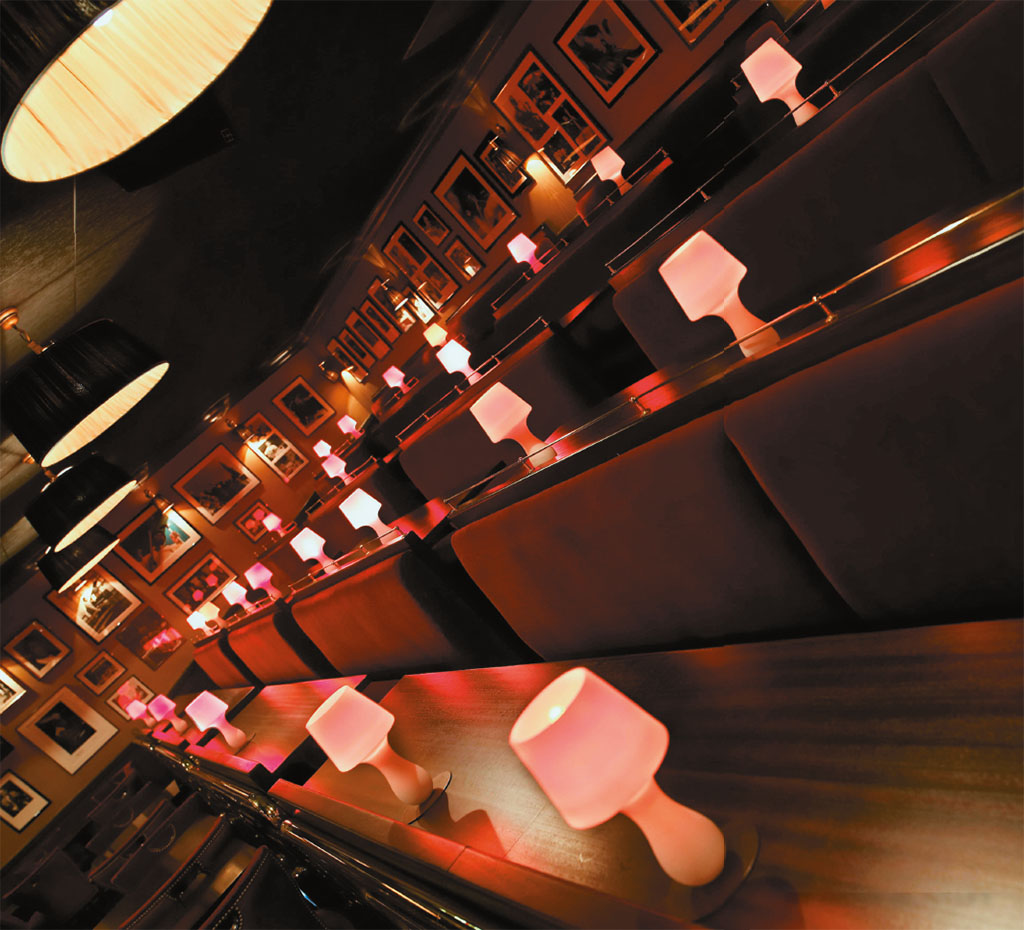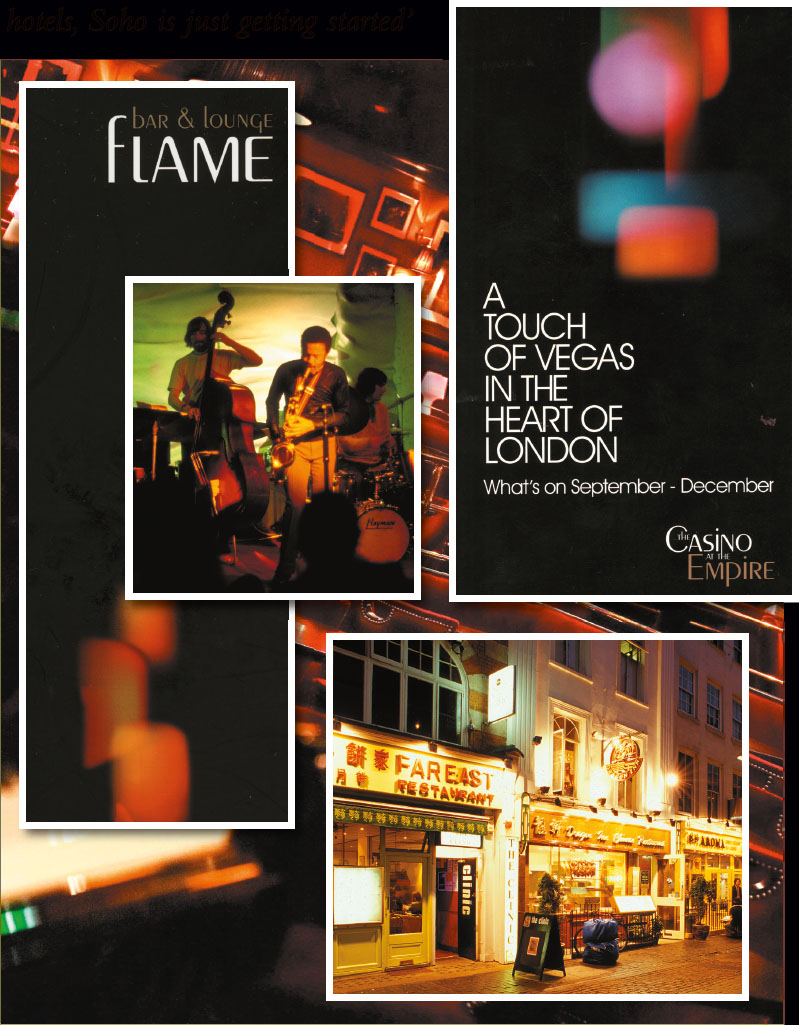
By day, folks go to the cinema or buy fresh vegetables at Berwick Street Market. At night, this is where the city of London comes out to play!
[caption id="SohoAfterDark_Feature" align="aligncenter" width="1024"]

COURTESY OF RONNIE SCOTT’S
ON OLD COMPTON STREET, running west from Cambridge Circus toward Regent Street, the G-A-Y nightclub sits next door to the Prince of Wales Theatre, where they’ve been playing Mary Poppins. On the other side is Lion City, long my favorite Thai restaurant in town. Only in Soho.
Over the past couple of years, British Heritage has wandered the neighborhoods of London, profiling the city’s villages from Chelsea to Greenwich, Bloomsbury to South Kensington. In the very heart of central London, the bull’s-eye within the Circle Line, sits Soho, bordered by Leicester Square and Oxford Street, Regent Street and Charing Cross Road. This is the theater district, the place that gives the West End its distinctive character. This is the underbelly of central London, where by day folks shop for vegetables and sausages at Berwick Street Market, and by night London comes out to play.
I rendezvoused for supper with British Heritage columnist Sandra Lawrence and friends at Garlic & Shots on Frith Street. The title says it all. There are a hundred different concoctions on the shots menu. I tried the Bloodshot, a concentrated Bloody Mary jacked with garlic and red pepper, then settled down to a garlic beer, with shards of crushed garlic floating in the foam. The rest of the experience isn’t for the faint of heart or sweet of breath either.
Garlic & Shots is Goth and gothic. There’s a vague vampire motif in the décor, along with some R-rated humor and assorted Johnny Cash memorabilia. Every third disk in the music system plays Johnny Cash. Virtually everything on the imaginative menu, in English and Swedish, is garlic infused in one form or another. It was all delicious, from the roasted garlic and garlic bread to the garlic curried prawns. “I keep a close watch on this heart of mine,” sang Johnny. Only in Soho.
Until the mid-17th century, Soho was grazing farmland and then a royal park for the Palace of Whitehall. Its name is popularly believed to derive from an old hunting call (as in, “Soho, the fox!”). Like its western neighbor, Mayfair, the area was developed in the late 1600s and became an early settlement area for French Huguenots. Though it never became a very fashionable residential district, by the early 20th century Soho was an international community, with music halls and theaters, ethnic eating houses and pubs. The bohemian element drifted in, and Soho became the hangout for writers and artists.
‘When the theaters spill out and out-of-town folks head to their hotels, Soho is just getting started’
We wandered through the milling crowds down across theater-lined Shaftesbury Avenue toward Leicester Square. Pedestrianized Gerrard Street is the crossroads of Chinatown, full of restaurants with rows of orangey smoked ducks hanging in the windows and oriental supermarkets selling lychees and daikon by the basketful.
LEICESTER SQUARE itself has delighted in the lights since the 1800s. Famous music halls gave way to cinema palaces, and it has remained an entertainment center ever since. On the south side, the official half-price theater ticket booth, which sells day-of-performance tickets only, draws crowds throughout the day. On the north side, the Empire, once cinema, once ballroom, is now London’s largest and poshest casino—“A Touch of Vegas in the Heart of London.”
The Casino at the Empire, like all British casinos, is a membership club. That used to be off-putting to overseas visitors. Now, however, membership is free and available at the door. Simply show up with a passport or photo ID and be prepared to have your picture taken. I did.
While the Empire certainly can’t compare with Las Vegas in scale, it succeeds in bringing the style. The mezzanine floor is a circle of chic dining and lounging options with an area of electronic games. Below lies the casino floor itself, devoted to table games. Apart from dice games, all the usual suspects are present; roulette is a particular favorite. With a £5 minimum table bet, however, punters can drop a lot of cash if they don’t know what they’re doing.
After exploring the world of the Empire, we settled down to visit at Flame, its premier cocktail lounge. Frank, the barman, entertained us building items from Flame’s menu of elaborate cocktails. He began a “BBC” for Sandra by muddling fresh blackberries; whisking the mix with Courvoisier, Crème de Mure and cranberry juice, he sieved it over crushed ice and garnished it with more blackberries. A “Gin Garden” starts with muddled cucumber, lemon juice and elderflower cordial, then adds gin and chilled Earl Grey tea. Frank was as entertaining as his drinks.
When the theaters spill out and out-of-town folks drift back toward their hotels in Bloomsbury or South Kensington, Soho is just getting started for the night. This is a good-natured underbelly. The crowds are festive and fun, rather than menacing. We left the Empire on the wane of the post-theater crunch and headed back up toward Old Compton Street.
Trattorias and curry houses, pubs and patisseries, sex shops and music clubs: Soho after dark is for adults. Old Compton Street is the entertainment center of London’s gay community. A few blocks north from Shaftesbury Avenue, the neighborhood houses much of London’s film, video and music industries. Parallel to where Regent Street borders Mayfair, Carnaby Street is a pedestrianized shopping area that still retains much of its buzz from the swinging ’60s. Remarkably, there is a strong residential community in Soho, as multicultural as its eating options and the cheery mingling nighttime crowds.
The later the evening gets, the more Soho becomes a de facto pedestrianized zone. Vehicle traffic enters Old Compton Street and the environs at its own peril. Over the last 10 years, the streets have been increasingly taken over by modern-day rickshaws, pedal-powered people movers that can navigate short distances in the West End even more efficiently than London taxis.
WE TOOK THE EVENING to its grand finale at Ronnie Scotts, just down the street from Garlic & Shots. A Soho fixture since 1959, Ronnie Scotts Jazz Club is the premier London jazz venue. This is an old-style nightclub where tiered seating for about 250 rises around three sides of the performance stage, with subdued indirect lighting, shaded table-lights and waiter service. The legendary jazz greats of all time have played Ronnie Scotts. In fact, they still do—seven nights a week. Rising young musicians from America and Britain play supporting sets for the most famous names in jazz. We caught the end of a set with headliner George Fame, an old-time master on the Hammond, and settled in to listen to the smooth house band, the Ronnie Scott All Stars, wail the night away.
IT WAS DRIZZLING HEAVILY as we left Ronnie Scotts well after midnight. The street scene had just begun its early morning mellow-out, and down on Shaftesbury Avenue we scattered to hail the stray, elusive cab. You know how it is in London. It’s murder to find a taxi at night in the rain. The rickshaws had disappeared, too. Only in Soho.
[caption id="SohoAfterDark_img1" align="aligncenter" width="799"]

BACKGROUND: RONNIE SCOTT’S; LEFT AND RIGHT: COURTESY OF THE CASINO AT THE EMPIRE; TOP AND BOTTOM: BRITAINONVIEW





Comments